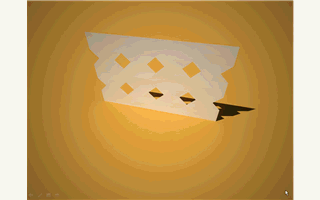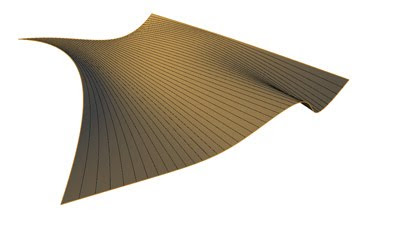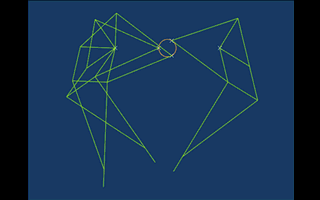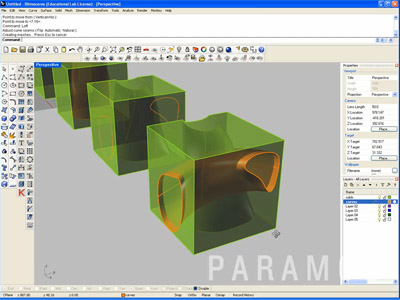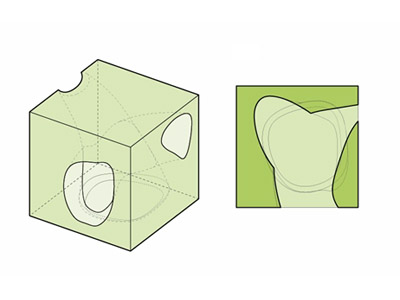We had some snow last week. I rushed over to the botanical gardens to check out the pavilion and was pleasantly surprised to find snow shadows, or maybe the opposite of shadows, focused piles of snow corresponding to each cone. Now I am waiting for a good ice storm to see if we get icicles for each cone.
Sunday, December 13, 2009
Next iteration of the folding panel
After trying a few options for the folding screen, here is one that uses the corner (or a fold in the surface) to open. I was hoping for a more dramatic range from closed to open but the range is based on the range of the individual module.
I was a bit lazy with the animation, only a few versions to show the range of motion. The panel as rendered is 7 feet high by 9 feet wide.
I was a bit lazy with the animation, only a few versions to show the range of motion. The panel as rendered is 7 feet high by 9 feet wide.
Labels:
assembly model,
project
Tuesday, December 8, 2009
The next project with John and Cezanne
John, Cezanne, and I have been working / talking about the next project since this past summer. While we are still in the early stages, or at least my part of it is in early stages, I had a break through with the assembly modeling component in DP. The installation will be at a museum in Japan and we are trying to work with a repeated interactive module and origami. Below is a simple animation of the repeated parts as they fold. The top left corner is fixed, and as a result as the parts change, it impacts all the connected modules.
Below are a few of the parts simply arranged that also rolls the surface into a cylinder.
Labels:
assembly model,
developable,
parametric,
project
Wednesday, November 25, 2009
To some, this might seem redundant.
Labeling a stack of plywood, "PLY". The joke is that that is the name of the office. The driver did not appreciate that I asked him to step aside so I could take a picture.

Labels:
misc
Hydrophobic Surface Mapping
I have been working on a new knowledge pattern project that maps the flow over a surface. The bigger project is to develop a new form of tiling that incorporates performance into the patterning and surface subdivision. In the first series below, you can see the various steps to the flow pattern (the original surface, the first knowledge pattern that creates a set of isocurves, and then the lines of flow based on the difference between vertical and the surface normal at that intersection.
Below are a couple of variations as the surface is manipulated. The next immediate step is to capture the lengths of the lines and possibly vary the line weight to better graphically represent the impact of slope. (click the image for a larger view)
Another iteration. (click for larger view)
Below is an obvious example of water moving across a surface. The Lotus Leaf surface is "hydrophobic", keeping it clean because of its ability to repel water.
Labels:
knowledge pattern,
parametric,
project
Monday, November 23, 2009
Back from CA
Had a great trip out to CalPoly SLO this past weekend. The student work that I saw looked very interesting and I also had a chance to see the progress of a design build studio led by Mark Cabrinha. I was also blown away by reviews outside, could never happen in Michigan.
Obviously had to get some good food along the way. In and out burger a must at LAX and Sushi Gen an LA favorite.
Labels:
misc
Wednesday, November 18, 2009
Lecture on Friday
On Friday November 20th, I'll be lecturing at CAL POLY as part of the Hearst Lectures. The theme this term is "Integrated Practices". I will be discussing current work from PLY and recent research interests at U of M.
Labels:
misc
Monday, November 2, 2009
Knowledge Pattern Tweek
So it was a simple test tonight, maybe just to try it and see if it worked. I am already plotting the next tutorial that will involve some form of 'intelligence' for the insertion of UDFs. The simple test tonight was to color the UDF based on the even or odd values of i and j. Since there is no even or odd, I had to use MOD. In this case there are if/else statements to change the color.
Future tutorial will create a script that decides which UDF to insert given a certain condition. At least this is where I am heading. It will probably just be a simple condition, but way in the future this might be based on curvature or planarity.
Using the previous tutorial you can insert the following text in place of the p1.color line:
if mod(j,2)<1 and mod(i,2)<1
p1.Color = "143,188,143"
p1.Color = "143,188,143"
else if mod(j,2)>0 and mod(i,2)>0
p1.Color = "193,205,193"
else
p1.Color = "193,205,193"
else
p1.Color = "131,139,131"
Labels:
knowledge pattern,
parametric
Sunday, November 1, 2009
Knowledge Pattern Tutorial
Here is the first knowledge pattern tutorial. The tutorial is broken into two parts, the first part steps through the process for the creation of a framework and the second part inserts the surfaces into the framework.
link to PART1 Video Tutorial
link to catscript sample file for part 1
link to PART2 Video Tutorial
link to catscript sample file for part 2
Labels:
knowledge pattern,
parametric,
tutorial
Thursday, October 29, 2009
Gearing up for Knowledge Pattern Tutorial
I took some time this past weekend to work through the knowledge pattern process again for myself. Prior to the workshop I had never even used a UDF, now I am scripting interactions as part of the process. Look for an initital (provisional) knowledge pattern tutorial very soon.
Given this advancement, I am sure to have to re-work my upcoming graduate seimar to focus on knowledge patterns. Image of most recent tests where the script counter is driving the color, depth, and aperature. I am also trying to think up an approach where the script will create geometry that is not based on a surface but based on the previously instantiated part.
Given this advancement, I am sure to have to re-work my upcoming graduate seimar to focus on knowledge patterns. Image of most recent tests where the script counter is driving the color, depth, and aperature. I am also trying to think up an approach where the script will create geometry that is not based on a surface but based on the previously instantiated part.
Labels:
knowledge pattern,
parametric
Wednesday, October 21, 2009
Knowledge Pattern - Game Changer
Just got back from a 3 day intensive workshop with Gehry Technologies at the pre-acadia sessions. It was a session led by Nuri Miller and Neil Meredith and it was focused on knowledge patterns. Imagine being able to script the insertion of powercopies and change the count or modify the replicated part and have the software re-insert the new part in seconds. Your wish has been granted, and I know how to do it now. For anyone that has inserted hundreds of parts 'by hand' before you appreciate this. For others, I am way off in tech-geek land. Knowledge pattern tutorials will proliferate paramod.net!
While I appreciated the workshop, I must say that the ACADIA planning leaves much to be desired. Next time you advertise the workshop in Chicago make note that Evanston is NOT Chicago and is a 1 hour public transportation trek. Everything was downtown but the Digital Project and EcoTech sessions. Maybe Rhino bribed the ACADIA planner? In any case, I would like to get a refund for the 6 hours I spent on a crowded train. Or if you organize a shuttle bus, maybe it should pick people up at the conference hotel not 4 miles away. Maybe I should also request a refund for the difference between a hotel in Evanston and the expensive conference hotel I booked in Chicago where I thought the conference was. I am feeling a bit better, deep breaths. I was starting to like the seclusion offered by our sequestered location until today when the classroom above us was also being used by a different conference group that was demo-ing hammer drills into the concrete slab. I'll stop now for fear of coming off like an international cry-baby. I just don't understand the thinking. Every participant had their own laptops so it was not that the software was only available outside the city limits.
I met a bunch of great people all using the same tools in different ways, clamoring to share stories and approaches. I sat next to an old friend (Mark Weston) so that was fun too. It was fun to watch Mark drive the instructors crazy with his desires to make his parts use random numbers and pull in information from the stock market to produce curves. AEC Industry software meets Mr. Wizard! Not to mention his own special brand of names for variables and files.
Here are a couple of images from the part I was working on today. The color is produced by the script that color codes the panels based on location and aperature depth.
While I appreciated the workshop, I must say that the ACADIA planning leaves much to be desired. Next time you advertise the workshop in Chicago make note that Evanston is NOT Chicago and is a 1 hour public transportation trek. Everything was downtown but the Digital Project and EcoTech sessions. Maybe Rhino bribed the ACADIA planner? In any case, I would like to get a refund for the 6 hours I spent on a crowded train. Or if you organize a shuttle bus, maybe it should pick people up at the conference hotel not 4 miles away. Maybe I should also request a refund for the difference between a hotel in Evanston and the expensive conference hotel I booked in Chicago where I thought the conference was. I am feeling a bit better, deep breaths. I was starting to like the seclusion offered by our sequestered location until today when the classroom above us was also being used by a different conference group that was demo-ing hammer drills into the concrete slab. I'll stop now for fear of coming off like an international cry-baby. I just don't understand the thinking. Every participant had their own laptops so it was not that the software was only available outside the city limits.
I met a bunch of great people all using the same tools in different ways, clamoring to share stories and approaches. I sat next to an old friend (Mark Weston) so that was fun too. It was fun to watch Mark drive the instructors crazy with his desires to make his parts use random numbers and pull in information from the stock market to produce curves. AEC Industry software meets Mr. Wizard! Not to mention his own special brand of names for variables and files.
Here are a couple of images from the part I was working on today. The color is produced by the script that color codes the panels based on location and aperature depth.
Labels:
knowledge pattern,
parametric
Thursday, October 15, 2009
Shape Shifters
How does JJ Abrams do it?
In the most recent episode of Fringe (Momentum Deferred), Agent Dunham to Agent Broyles "I am not worried because if a shape shifting assassin from another universe wanted me dead, then I would be".
This comes across like a totally believable condition, not worthy of even pausing.
In the most recent episode of Fringe (Momentum Deferred), Agent Dunham to Agent Broyles "I am not worried because if a shape shifting assassin from another universe wanted me dead, then I would be".
This comes across like a totally believable condition, not worthy of even pausing.
This is relevant because shape shifters are very cool.
Labels:
misc
Wednesday, October 7, 2009
Future of Design
Friday and Saturday (Oct 9-10) we are hosting an amazing line-up of theorists, designers, architects, educators to discuss the future of design. It will be at Rackham Auditorium (seats 1000) so be sure to be in Ann Arbor this weekend. It is a free event and open to the public.
Here is a link to the details: Future of Design
Here is a link to the details: Future of Design
Labels:
misc
Sunday, October 4, 2009
Signs of Fall at the botanical garden
I had a chance to go out to the shadow pavilion this weekend to make sure it was still standing. It is still there and the colors of the trees are starting to change.
Labels:
developable,
project,
rhino scripting
Monday, September 28, 2009
Intro to VRay for Rhino
Just came across a VRay tutorial that I made this past summer. It was for the 3G1's, but will be applicable for others. It covers simple lighting, materials, and options and then adds people and shadows in photoshop.
Click on the image to start the video.
Click on the image to start the video.
Saturday, September 26, 2009
SmartSurfaces - Digital Project PowerCopy Sun Tracker
Tutorial based on demo from SmartSurfaces. The tutorial covers the creation of powercopies with embedded / dynamic parameters.
Click image to launch video.
Click image to launch video.
Labels:
powercopy,
smartsurfaces,
tutorial
SmartSurfaces - Digital Project Theo Jansen Tutorial
Digital Project tutorial builds a Theo Jansen leg mechanism to explain sketches and constraints.
Click image to view tutorial.
Click image to view tutorial.
Labels:
smartsurfaces,
tutorial
Rhino Surface / Soild to Line Drawing
Tutorial works through the modeling of surfaces and soilds using different CPlanes. The model is then output using Make2D and brought into Illustrator.
Click either image to watch the video.
Click either image to watch the video.
Saturday, September 19, 2009
SmartSurfaces is up and running
The SmartSurfaces course had its first meeting on September 11. There are 24 U of M undergrads enrolled (8 from Arch, 8 from Art and Design, 8 from Material Science). The students will form 4 teams to design and build a final prject that explores interaction, fabrication, and heliotropic structures.
At the heart of the course and the project is the Arduino open-source electronics prototyping board. This past week we had all the students working with their Arduinos.
The course website has an absolutely amazing set of Arduino resources and original tutorials produced by John Marshall. Students will be posting their work to the site, so it will be worth checkinh back.
Here are a couple of videos of the students' Arduino studies after a couple of hours:
Briena - Color mixing with 3 LEDs.
Peter - Light sensor controling an LED

Peter - Dialing in the servo motor
At the heart of the course and the project is the Arduino open-source electronics prototyping board. This past week we had all the students working with their Arduinos.
The course website has an absolutely amazing set of Arduino resources and original tutorials produced by John Marshall. Students will be posting their work to the site, so it will be worth checkinh back.
Here are a couple of videos of the students' Arduino studies after a couple of hours:
Briena - Color mixing with 3 LEDs.
Peter - Light sensor controling an LED

Labels:
arduino,
smartsurfaces
VRay Section with accurate lighting
Tutorial shows how to create a section rendered with VRay. In order to do this a material needs to be made that is invisble but still casts shadows.
Click the image to watch the video.
Click the image to watch the video.
Tuesday, September 15, 2009
Digital Project - Beginner Solid Modeling
This video tutorial uses the content from an earlier Rhino tutorial to discuss basic soild modeling techniques in Digital Project.
Click the image to watch the video.
Click the image to watch the video.
Labels:
parametric,
tutorial
Sunday, September 13, 2009
Rhino - Misc Modeling Tips
This video tutorial covers perspective, physical model output, and various drawing techniques.
Click the image to watch the video.
Click the image to watch the video.
Intro Rhino Tutorial - Soilds
This short video tutorial covers the production of simple volumetric space using solids. It was developed for the 3G1 studio this summer.
Click the image to watch the video.

Click the image to watch the video.

Tuesday, September 8, 2009
Pavilion Photos
Here are a few more photos that were taken of the pavilion with a long exposure during the full moon.


Labels:
developable,
project,
rhino scripting
Tuesday, August 25, 2009
All the big parts in place
Still some minor modifications to be made, but all the big parts were installed today with the help of Peggy, Alex, and Katie. The light and sound quality of the megaphones is constantly changing based on the variations of the site. Most people walking along the trail don't know what to make of it, but they all agree "It's interesting" or "different".
Labels:
project
Monday, August 24, 2009
Progress Continues
Work continued today. While it was nice to see it in the sun, there was still not enough shade created to stay cool. Four more "chunks" to install,maybe done on Tuesday. Once the final parts are in place the temporary bracing can be removed.
Labels:
project
Sunday, August 23, 2009
Big Assembly Day
Ngoc Thy, Alex, and I had a few extra hands on site today to help hold and rivet. Thanks to Dwight, Jessica, Craig, and Jen for giving up their Sunday. All the parts are on site now with five "chunks" left to install. We hope to have the remaining pieces installed this week.


Labels:
project
Saturday, August 22, 2009
Assembly on site
This week we began setting the base of the pavilion. The first stage is a bit time consuming as the first row is anchored to the ground and filled with gravel. The next stage will be the assembly and installation of the ‘oculus’ at the northern edge.


Labels:
project
Sunday, August 16, 2009
Shadow Pavilion cleared for construction
On Friday we received word that the Shadow Pavilion has been cleared by the University Review Committee for construction. Most of the parts are assembled and are ready to be moved to the botanical Gardens.
 The site is being prepped this week and the installation will begin, weather permitting.
The site is being prepped this week and the installation will begin, weather permitting.

 The site is being prepped this week and the installation will begin, weather permitting.
The site is being prepped this week and the installation will begin, weather permitting.
Labels:
developable,
project,
rhino scripting
Ayaka Ceiling Complete
Ayaka Sushi is open. Here are a couple of images of the completed ceiling in the space. Once the panels were assembled in the shop Marshall and Alex spent two days installing the six suspended panels.
Because the panels fold over and are painted with two different colors, from one direction it is more white from the other more orange is exposed.


Because the panels fold over and are painted with two different colors, from one direction it is more white from the other more orange is exposed.

Labels:
developable,
parametric,
project
Subscribe to:
Posts (Atom)



